[Lecture Notes] UW-Madison CS564 Database Mgt Systems
Lec 2. SQL Basics I
Relational model
A database is a collection of one or more relations.
Relation: a table with rows and columns. (relation = table)
table name; attribute/column; record/tuple/row
Domain: (e.g. int, string. real…)
Schema:
- The schema of a relation: relation name + attribute names.
- The schema of a database: a collection of relation schemas.
Primary key: a subset of attributes that is a unique identifier of tuples in a relation.
- A primary key can have 1 or more attributes
- Primary key must be unique.
- A relation can only have 1 primary key, but can have multiple unique keys.
Structured Query Language (SQL)
- Data Definition Language (DDL)
- Creation, deletion, modification of definitions of tables
- Data Manipulation Language (DML)
- Query; Insert, delete and update rows
Basics (creating a table)
Create a Table
1 | |
Insert to a Table
1 | |
Single-table queries
Basic SQL Query
1 | |
select *: select all attributes of this relation.
SELECT sname AS sailorName: rename an attribute
SELECT sname, (60-age) AS YearToRetire: arithmetic expression (and rename)
In WHERE clauses:
- Attribute names
- Comparison operators:
=,<>,<,>,<=,>= - Arithmetic operations:
+,-,*,/ AND,OR,NOT- Operations on strings (e.g. concatenation)
- Pattern matching: (e.g.
s LIKE '%madison%') - Special functions for comparing dates and times
Pattern matching:
%= any sequence of characters_= any single character
Lec 3. SQL Basics II
Integrity Constraint
Integrity Constraint (IC): a condition specified on a database scheme and restricts the data that can be stored in an instance of database.
IC are specified when the user defines a database schema. 用户定义DB时会指明IC.
DBMS checks for violations and disallows changes to the data that violates the specified ICs (or make conpensating changes to the data to ensure all ICs are satisfied). DB会保证这种IC.
Foreign Keys
(Another way to declare primary key
1 | |
equivalent to
1 | |
)
Referenced attributes must be PRIMARY KEY (default) or UNIQUE. 被 foreign key 引用的属性必须是 primary key 或 unique (可以是多个属性的组合)
The foreign key in the referencing relation must match the primary key of the referenced relation.
Must have same number of columns and compatible data type.
The column names can be different. (Foreign key 必须类型相同, column 数量相同, 但名字可以不同)
A foreign key must reference a valid, existing key in the referenced table. Foreign key 不能指向空的key。
Syntax
1 | |
Example:
1 | |
Foreign key constraint can be violated in:
A new row is inserted to
Enrolledand references nonexistant value in `Students. (Foreign key 没有对应的 record, 拒绝插入操作)- Operation will be rejected.
A deletion or update to
Studentscauses some tuples ofEnrolledto dangle.不写默认是 NO ACTION
Solution 1: ON DELETE/UPDATE NO ACTION 不允许删除
- disallow (reject) deletion of the Students row (default).
Solution 2: ON DELETE/UPDATE CASCADE 级联 连着一起删除或修改
- delete/update rows in Enrolled that refer to the deleted Students row
Solution 3: ON DELETE/UPDATE SET DEFAULT 设成指定的默认值
- Set
studidto some default value City varchar(255) DEFAULT 'Sandnes'
- Set
Solution 4: ON DELETE/UPDATE SET NULL 设成空
- Set
studidvalue to null
- Set
Can specify the actions on DELETE and UPDATE separately (differently).
Multi-table queries
Semantics of SQL: Multuple Tables
1 | |
e.g. names of students who got A in EE101
1 | |
Lec 4. Advanced SQL I
SQL: Aggregation
SUM,AVG,COUNT,MIN,MAXcan be applied to a column in aSELECTclause.COUNT(*)counts the number of tuplesCOUNT (DISTINCT <attribute>)to remove duplicates before counting.If
SELECTclause uses an aggregate operation, it must use only attribute operations unless the query contains aGROUP BYclause.Note: attribute and aggregated attribute cannot appear in
SELECTat the same time.For example this is incorrect!
SELECT S.sname, MAX(S.age).Follow a
SELECT-FROM-WHEREbyGROUP BYand a list of attributes.The relation is then grouped according to the values of those attributes, and any aggregation is applied only within each group.
E.g.
1
2
3SELECT A, SUM(B*C)
FROM R
GROUP BY A;Restrictions: If any aggregation is used, each element in
SELECTmust be either aggregated or an attribute inGROUP BYlist.The
HAVINGclause always follows aGROUP BYclause in a SQL query.It applies to each group, and groups not satisfying the condition are removed.
It can refer only to attributes of relations in the
FROMclause.HAVINGapplies only on aggregates!
SQL: NULLs
When we do arithmetic operations using NULL, the result is NULL.
e.g.
(10*x)+5is NULL ifxis NULLString concatenation is NULL if one of the operands is NULL
e.g.
'wisconsin' || NULLis NULL3-valued logic: TRUE=1, FALSE=0, UNKNOWN=0.5
When any value is compared with a NULL, the result isUNKNOWN.- C1 AND C2: min{value(C1), value(C2)}
- C1 OR C2: max{value(C1), value(C2)}
- NOT C: 1 - value©
Test for NULL explicitly:
1
2X IS NULL
X IS NOT NULL
SQL: Outer Joins
Inner Joins
e.g.
1 | |
Alternative syntax:
1 | |
Left Outer Join
includes tuples from the left relation even if there’s no match on the right. Fills remaining attributes with NULL.
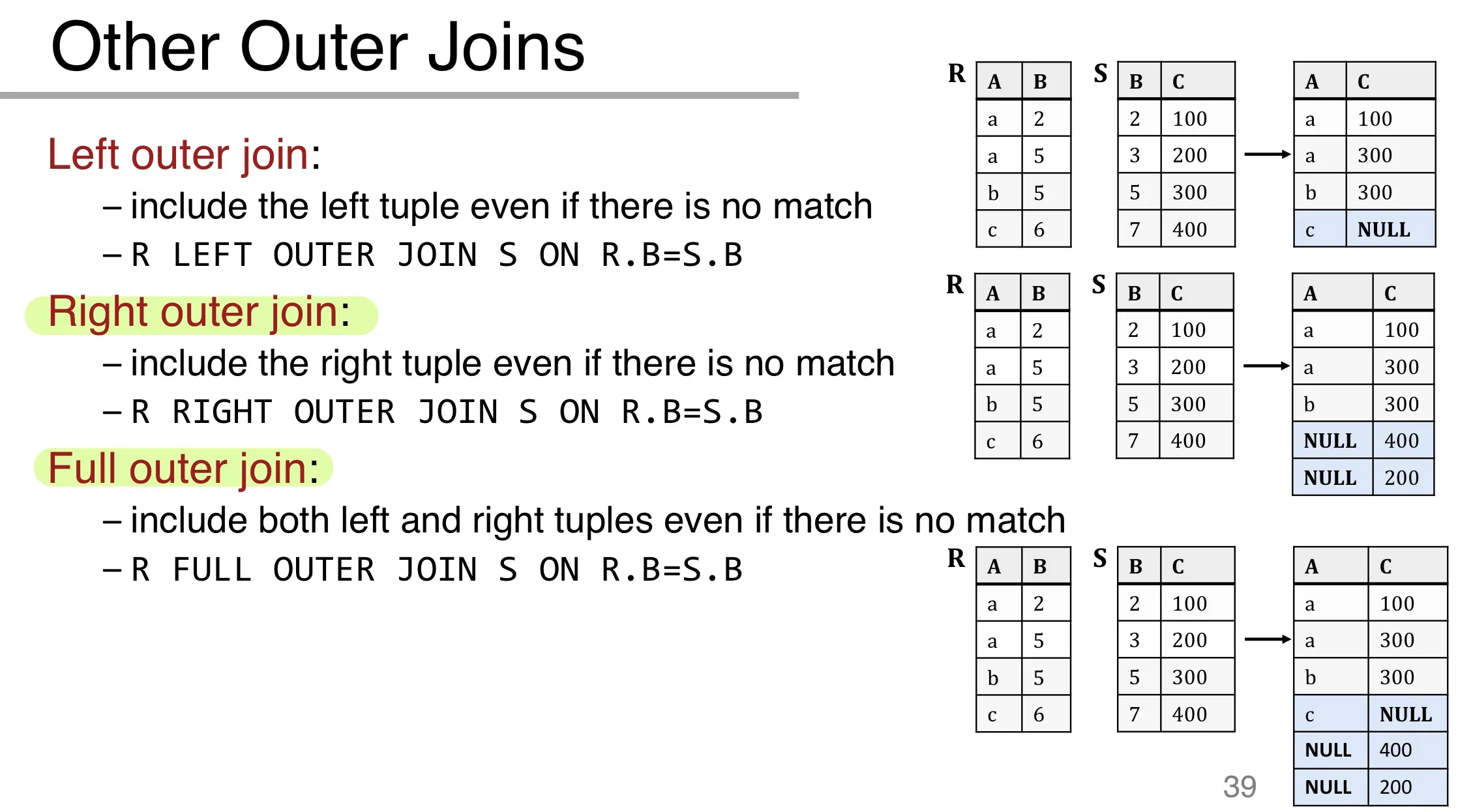
View
View: a virtual table based on the ouput set of a SQL query.
A View can be used like a normal table.
Lec 5. Advanced SQL II
Set Operators
Intersection 交集:
INTERSECTUnion 并集:
UNIONDifference:
EXCEPTIN/NOT INEXISTS/NOT EXISTSANYone ofALLall of
SQL 执行 Set operations 默认会去重. 加 ALL (e.g. UNION ALL) 可取消去重.
Nested Queries
FROM clause 和 WHERE clause 中可以使用 subquery.
Output of 1 query can be input to another query (nesting)
unnesting: find an equivalent SQL query that does not use nesting
Set comparison Operators
IN,NOT INEXISTS,NOT EXISTSop ANY(better than one of)op ALL(better than everyone)(
opis one of<, <=, =, <>, >=, >)
Lec 6. ER Model I
Database Design
- Requirements Analysis
- Conceptual Database Design
- Model high-level description of data; constraints; ER model
- Logical Database Design
- Choose a DBMS and design a scheme (How to map conceptual design to a schema)
ER Model
- A visual language to specify
- What information the DB must hold
- What are the relationships among components of that information
Concepts
Entity: distinguishable real-world object (a single object, e.g. one sailer).
Entity Set: A set of entities (all entities have same set of attributes, e.g. all sailors). Rectangles.
Attribute: attached to an entity set. Ovals.
(ER diagrams don’t represent entities. They represent entity sets!)
Relationship
Key Constraints:
- one-one: A and B are both keys to the relationship. Given an entity A (or B), can uniquely determine the relationship.
- many-one: Given an entity in B, can uniquely determine the relationship.
- many-many:
Lec 7. ER Model II
Roles in relationship
Lable the edges to indicate roles if one entity set plays more than one role
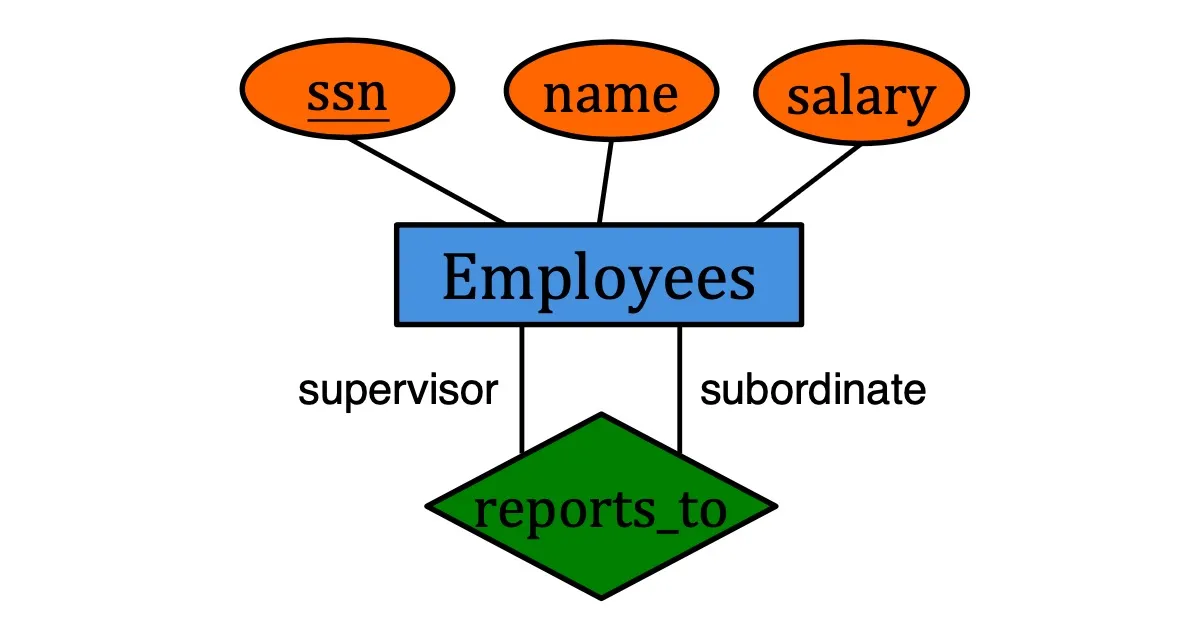
Participation constraint
- Key constraint: (at most one) (represented by →)
- Total participation: (at least one) (represented by thick line)
- Particial participation: (participation that is not total)
Weak Entities
A weak entity can only be identified uniquely by considering the primary key of another entity.
- Weak entity set must participate in one-to-many relationship set.
- Weak entity set must have total participation.
Example:

e.g. We cannot uniquely determine ‘dependent’ by ‘name’. Only by considering ‘employees’ can we determine ‘dependent’. Therefore ‘dependents’ is weak entity.
Class Hierarchy
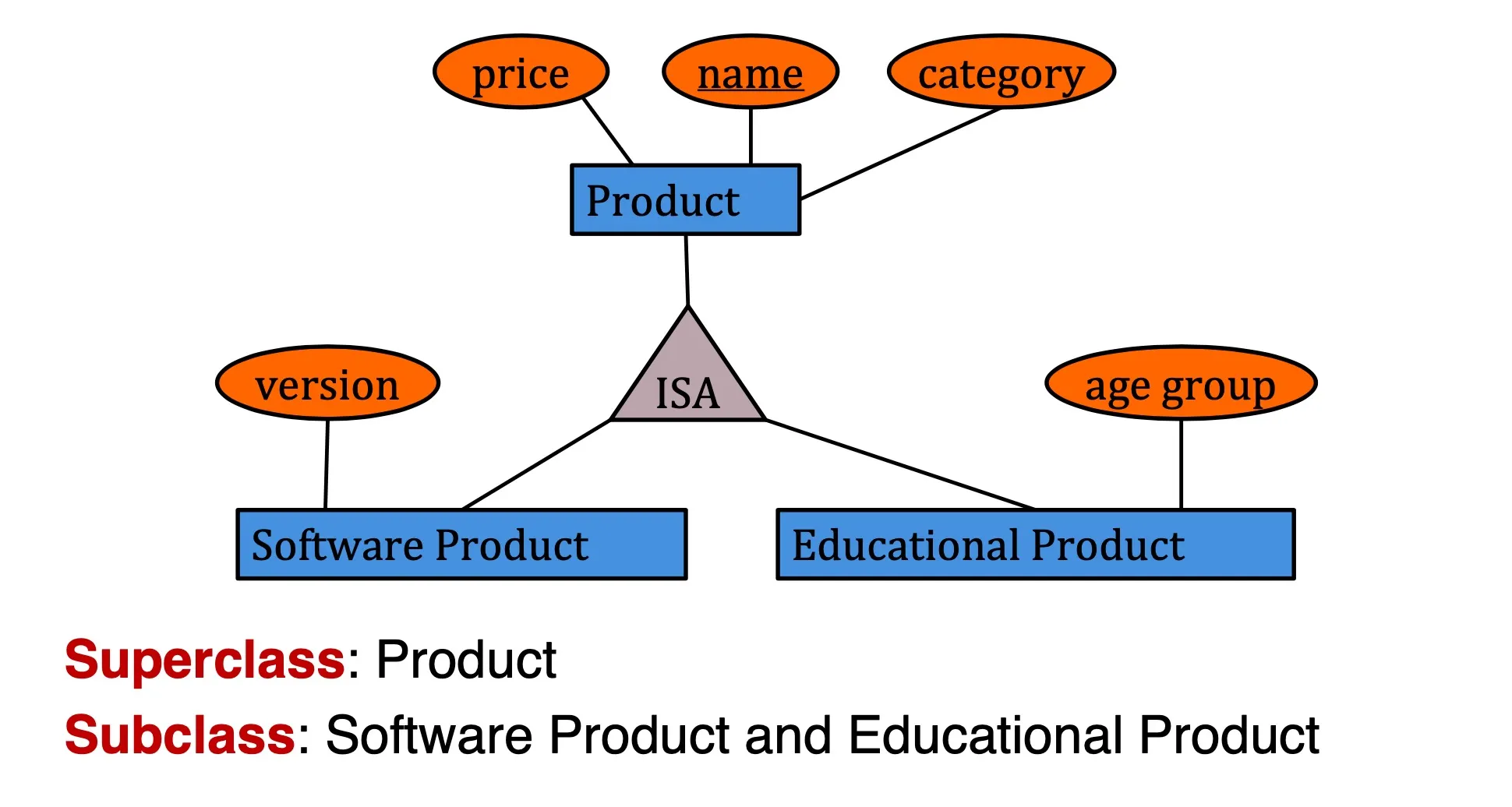
- Option 1: Don’t care about subclass relationship. Build 3 tables.
- Option 2: Similar to option 1, except that all products will be in Product table. Will have duplicates
- Option 3: Only build one table. Judge type by checking whether attribute is null.
Lec 9. Functional Dependencies
Functional Dependency (FD)
FDs are a form of constraint
When two tuples have the same A attributes, their B attributes must be same.
We then say that
- A functionally determines B
Given a table with a set of tuples, we can confirm that a FD seems to be valid, definitely invalid, but we cannot prove that a FD is valid.
Armstrong’s Axioms
Reflexivity: universal set can determine subset (e.g. )
Augmentation: if then (add attrib on both sides)
Transitivity: if and , then
Closure algorithm
FD Closure: if F is a set of FDs, the closure is the set of all FDs logically implied by F
Armstrong’s axioms are:
- sound: any FD generated by an axiom
- complete: can generate all
Attribute Closure: If X is an attribute set, the closure is the set of all attributes B that
Keys and Superkeys
superkey: a set of attributes that can determine all other attributes.
key (candidate key): a minimal superkey.
If a relation has multiple keys, we specify one to be primary key.
If = all attributes, then X is a superkey.
If no subset of X is a superkey, then X is also a key.
Lec 10. Decomposition & Normalization I
Decomposition
Decompose a relation into multiple relations.
| Lossless Join | Dependency preserving | |
|---|---|---|
| BCNF | Yes | Not always |
| 3NF | Yes | Yes |
Lossless-Join Decomposition
A natural join is a join on the same attribute names.
A schema decomposition is lossless-join if (natural join result) for any initial instance R.
Theorem: Let R be a relation and F be a sets of FDs that hold over R. The decomposition of R into R1 and R2 is lossless if and only if
- contains either or
(The common attributes must contain a key for / functionally determines either R1 or R2)
If and is empty, the decomposition into and is lossless.
Boyce-Codd Normal Form (BCNF)
A relation R is in BCNF if whenever is a non-trivial FD, is a superkey.
Equivalent Definition: For every attribute set , the closure of it is itself or all attributes.
The only nontrivial dependencies are those in which a key determines some attributes.
Normalization
Decompose into BCNF. (Keep decomposing until all relation is in BCNF).
Dependency-preserving: A decomposition is dependency preserving if by enforcing F1 over R1 and F2 over R2, we can enforce F over R.
Lec 11. Decomposition & Normalization II
Dependency-preserving decomposition
- The Projection of FD on attribute set is: the set of FDs in the closure that involve only attributes in .
- The decomposition of R is dependency-preserving if
Third Normal Form (3NF)
A relation is in 3NF if whenever , one of the following is true:
- (i.e. trivial FD)
- is a superkey
- is part of some key in
BCNF implies 3NF. (BCNF is more strict).
Every relation schema can be decomposed into a collection of 3NF relations using only decompositions that are lossless-join and dependency-preserving.
Minimal cover of FDs
A minimal cover for a set of FDs is such that
- every dependency in is the form where A is a single attribute
- Closure = Closure
- Deleting any dependency or attribute in ,
Calculate minimal cover:
- Step 1: Split the right hand side to single attributes
- Step 2: Remove redundant FDs
- Step 3: Clean up the left hand side
Decomposition into 3NF
- Step 1: Compute a minimal cover
- Step 2: Apply the algorithm for BCNF decomposition until all relations are in 3NF (early-stopping)
- Step 3: For each non-preserved FD in , add a new relation
Lec 12. Relational Algebra I
Relational Query Language
Allow the manipulation and retrieval of data from a database
Two types
- Declarative: describe what a user wants, rather than how to compute (SQL is declarative)
- Procedural: represent execution plan
Relational Algebra
an algebra whose operands are relations or variables that represent relations
Two types of notation for attributes
- positional (e.g. 第几列)
- named-field (e.g. 列的名称 Person.id)
SQL uses multisets, but in Relational Algebra we will consider relations as sets (无重复, DISTINCT)
Basic operations
1. Selection
- C是条件
- e.g.
- output schema = input schema
2. Projection
- 选择一部分columns, 且去除重复的tuples
- output schema:
- e.g.
3. Set union
- and must be union-compatible (相同schema); 输出 schema 与输入相同
- output all tuples in or , 且会去重
4. Set intersection
- and must be union-compatible
- output all tuples in and
- Can be defined by:
5. Set difference
- must be union-compatible
- output all tuples in and not in
6. Cross product
For every row in , pair with every row in
Input , output
attribute names 继承原来的名字, 但遇到 naming conflict 时会被 unnamed 并只能用position访问
7. Renaming
- Rename relation to , rename attributes according to
- e.g.
Derived Operations
1. Join (Theta Join)
- can be defined by: cross product followed by a selection
- 可以是条件
- might have less tuples than the cross product
- e.g.
2. Equi-Join
- Special case of Theta Join: condition contains only equalities between attributes (是theta join的特例, 条件必须是attribute相等的条件)
- Output schema: Fields of followed by fields of that do not appear in the join conditions (相同的attributes只会留一个)
3. Natural Join
- Special case of equi-join where equalities are specified on all fields having the same name in and .
- 如果 和 无同名 attributes, 相当于 cross-product
- 如果 和 的 schema 完全相同,相当于 intersection
Lec 13. Relational Algebra II
Division
- Suppose and
- Output contains all values such that for every tuple in tuple is in
- Output schema
- is the largest relation instance such that
TODO
Lec 14. Data Storage
DBMS architecture
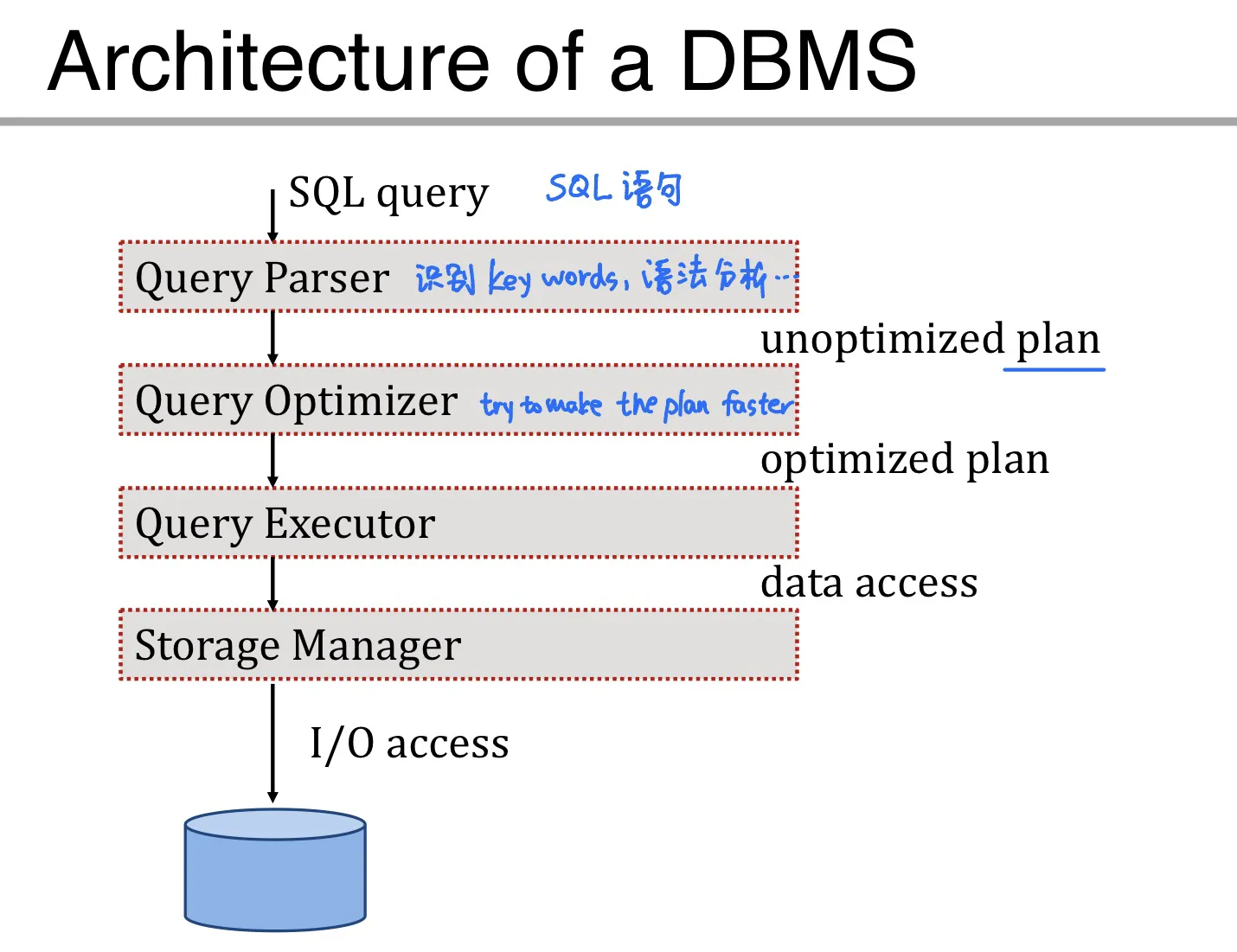
- Primary storage: main memory 内存 存储当前需要用到的data
- Secondary storage: disk 硬盘
- Tertiary storage: Tapes 用于 archive older versions of the data
Use buffer manager to move data from disk to main memory
Disk
Secondary storage
Data is stored and retrieved in units called disk blocks.
Components of disks
- Platter 盘片 数据存在这里
- Spindle 旋转
- Disk head 磁头 读取数据
- Disk arm
Data is encoded in concentric circles of sectors called tracks.
Block size: multiple of sector size (fixed)
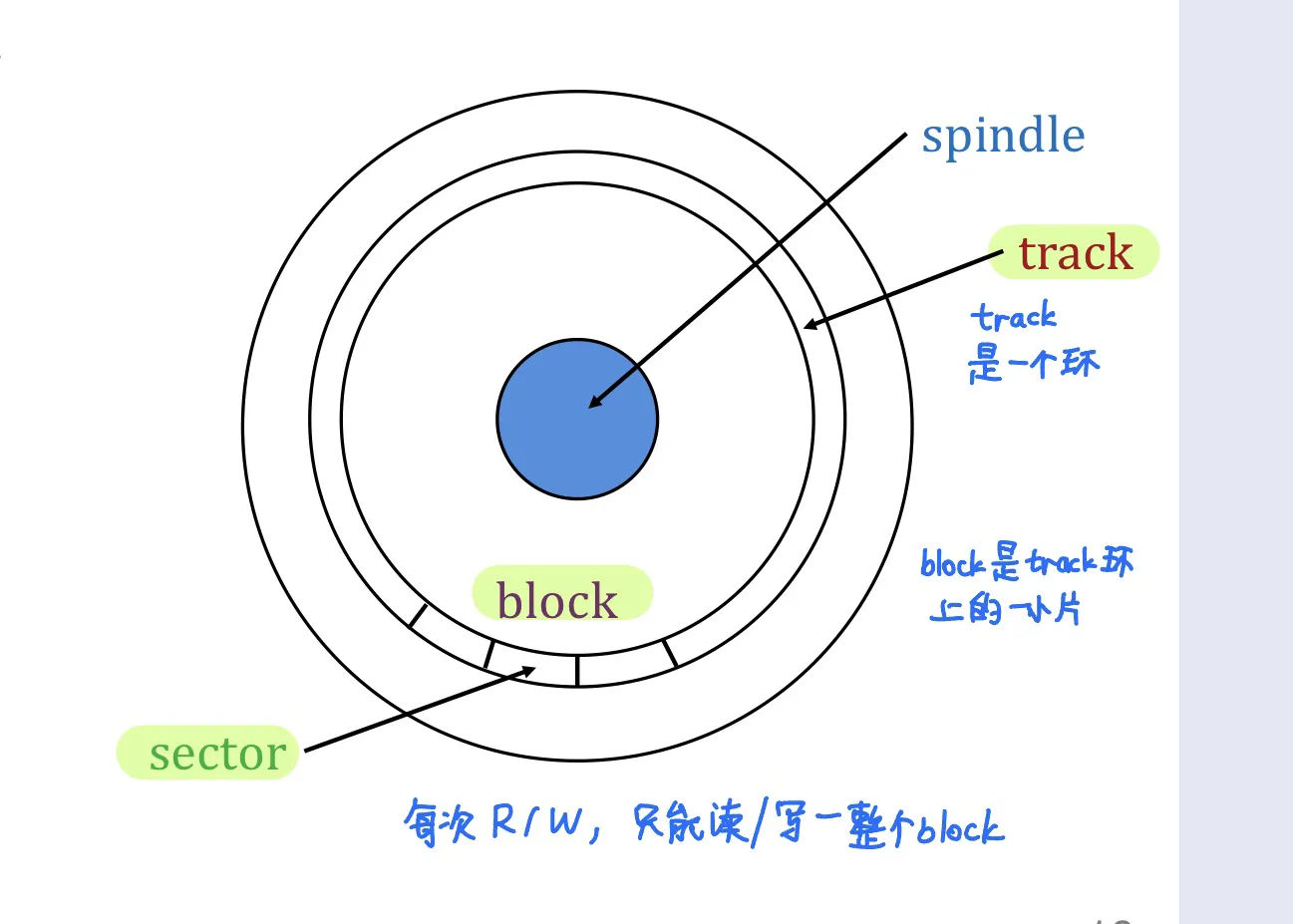
Access time = seek time + rotational delay + transfer time
Other storage devices
- SRAM: static random-access memory (CPU内的高速缓存)
- DRAM: dynamic random-access memory 内存
- SSD: solid state drive 固态硬盘
- NVM: non-volatile memory 介于DRAM和SSD中间, non-volatile + byte addressable
Lec 15. Buffer management
Group by aggregation
- group by attributes in X
- aggregate by the attribute in Y
- SUM, COUNT, AVG, MIN, MAX
Buffer management
Buffer manager: DBMS中的一个模块, 负责处理在disk和memory中移动数据
TODO
Lec 16. File Organization
DBMS vs. OS file system
DBMS is better at predicting the reference patterns
The disk space is organized into files
- File: a collection of pages
- Page: a collection of records
Heap files
Unordered (heap) files
contain the records in no particular order
As file grows/shrinks, disk pages are allocated/deallocated
To support scan: keep track of all pages in each heap file
To support insertion: keep track of pages that contain free space
Heap file as linked list
Each page has 2 pointers + data (pointer = page id)

Limitation: may examine multiple pages to find enough free space (more IO cost)
Heap file as page directory
Lec 21. Hashing
Static hashing
A hash index is a collection of buckets
- bucket = primary page + overflow pages
- each bucket contains index entries
- To find the bucket for each record, apply a hash function
- maps a search key to one of the buckets
Equality search (search key = value)
- apply hash function on search key to locate bucket
- scan through the bucket
- IO cost = 1 + number of overflow pages
Insertion
- Find appropriate bucket, insert the record
- if no space, create an overflow page
Deletion
- Find appropriate bucket, delete the record
- If it is the last record in an overflow page, remove the page
Hash functions
A good hash function is uniform (each bucket is assigned same # of values) and fast to compute.
works well in practice.
Limitations
- In static hashing, fixed number of buckets
- Rehashing
- Problem 1: expensive computation and data movement
- Problem 2: block query execution (cannot access hashtable during rehashing)
Extendible hashing
Intuition: when a bucket overflows, reorganize only the overflowing bucket (rather than all buckets)
Extendible hasing is a type of dynamic hashing
- keeps a directory of pointers to buckets
- overflow, reorganizes index by doubling the directory
Search
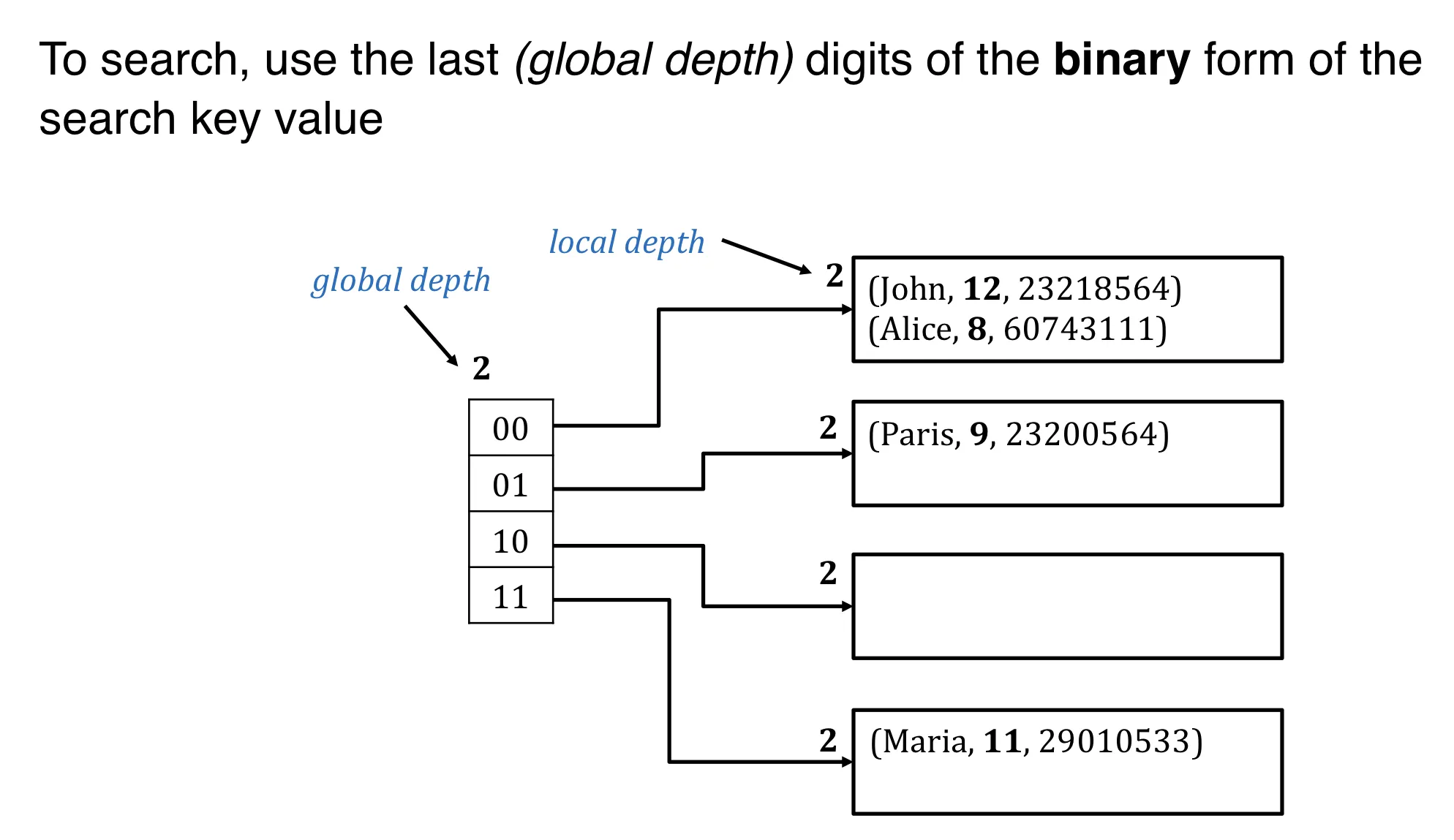
Insertion and split
If the bucket is not full, directly add the record.
If the bucket is full:
Step 1: allocate a new bucket and redistribute entries
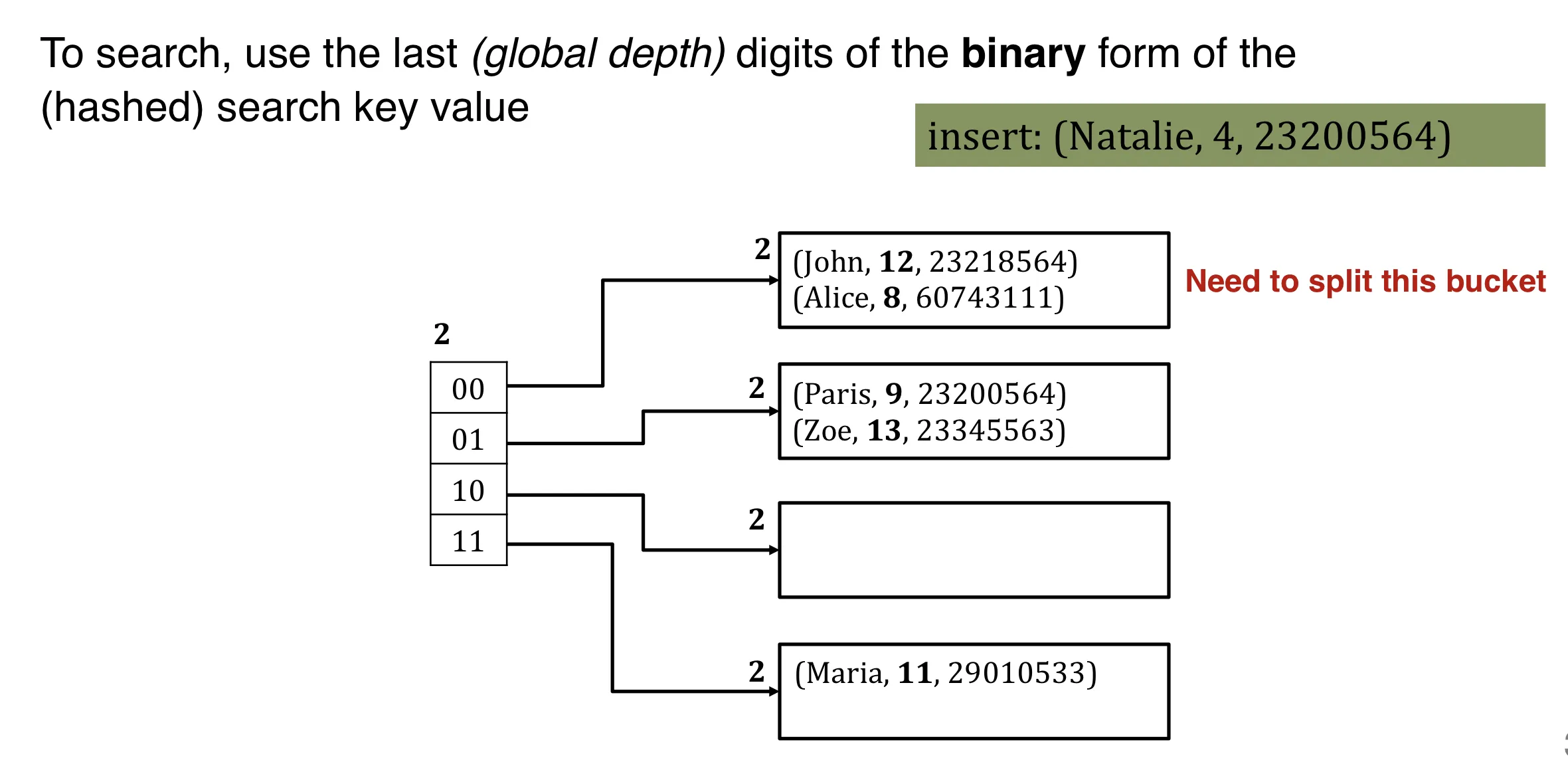
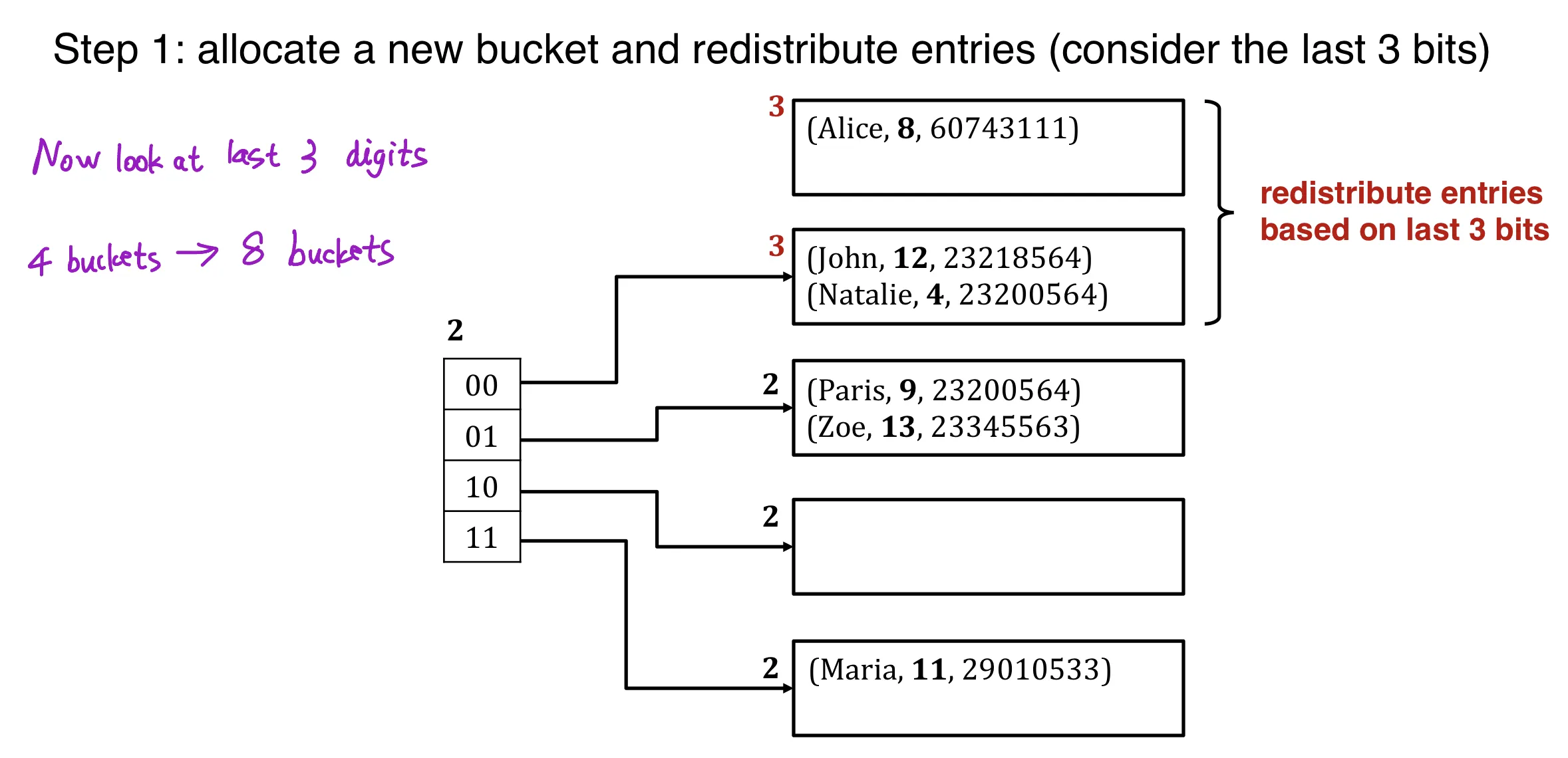
Step 2: double the directory (global depth++)
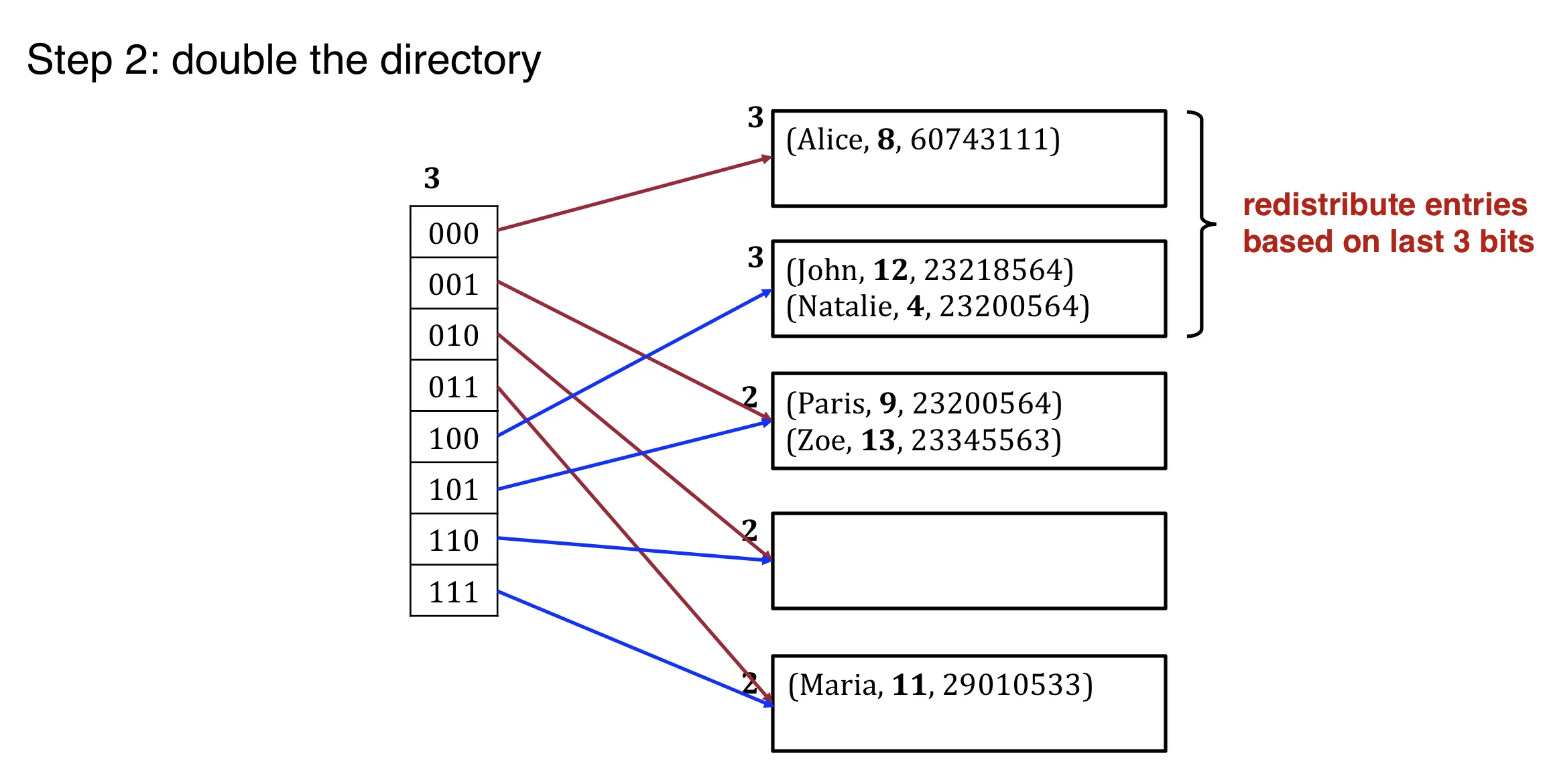
Global and local depth:
- global depth: how many bits to use to find the bucket
- local depth: incremented upon bucket split.
- double directory if local depth = global depth and bucket is full.
- 在bucket split时, 增加local depth, 但 local depth 不能大于 global depth
The directory(指针集合) is much smaller than buckets and can typically fit in memory.
Delete
Locate the bucket and remove the record.
If the bucket is empty, it can be removed (and update the directory)
2 buckets can coalesced together if sum of entries fit in a single bucket.
Decreasing the size of directory can also be done, but it is expensive.
Lec 22. B+ Tree
Hash index accelerates equality search.
Tree-based index accelerates both equality and range search.
B+ tree structure
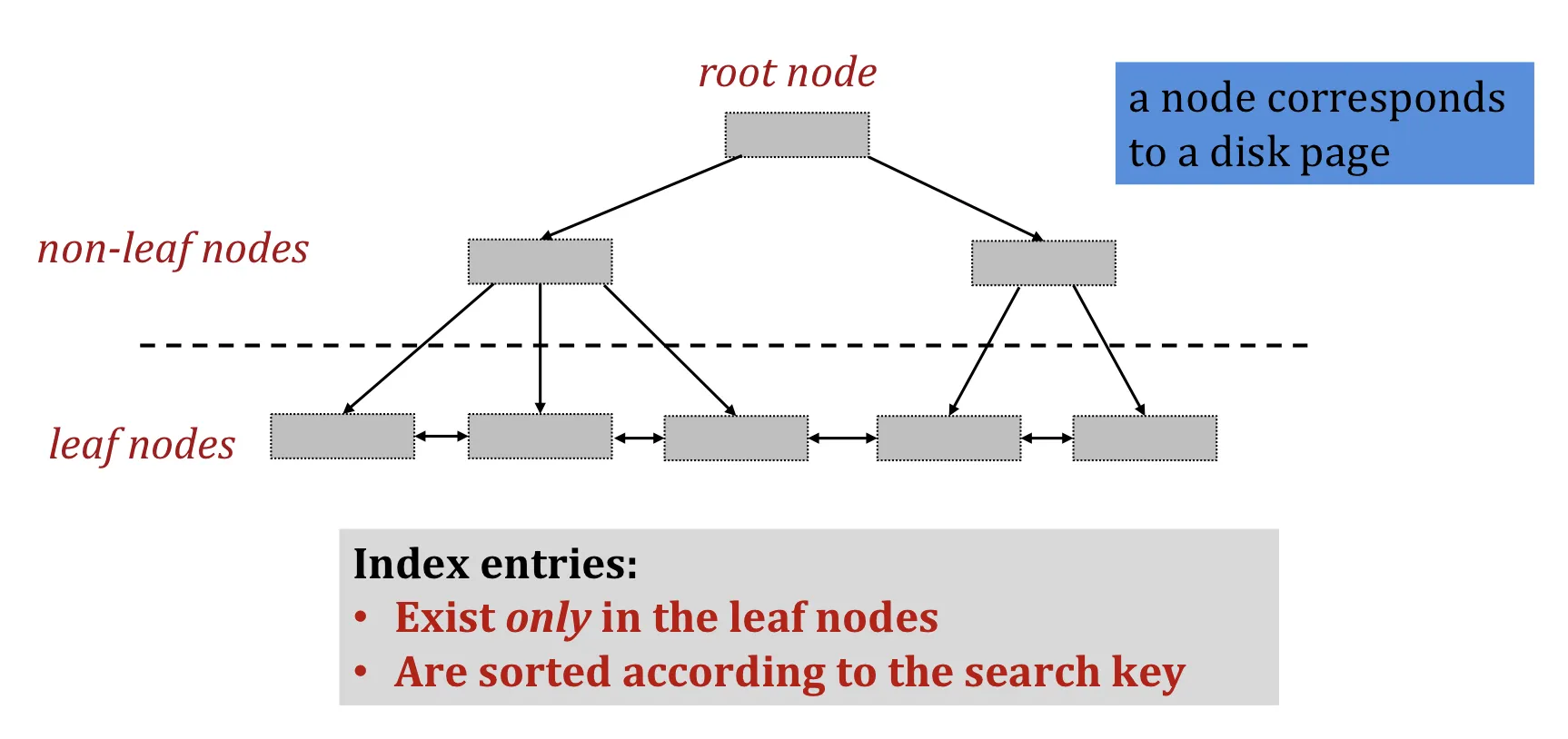
The parameter is the order of the tree.
Each node contains entries. (至少半满 50% occupancy, 否则浪费空间)
But root node can have entries
A non-leaf (internal) node with entries has pointers
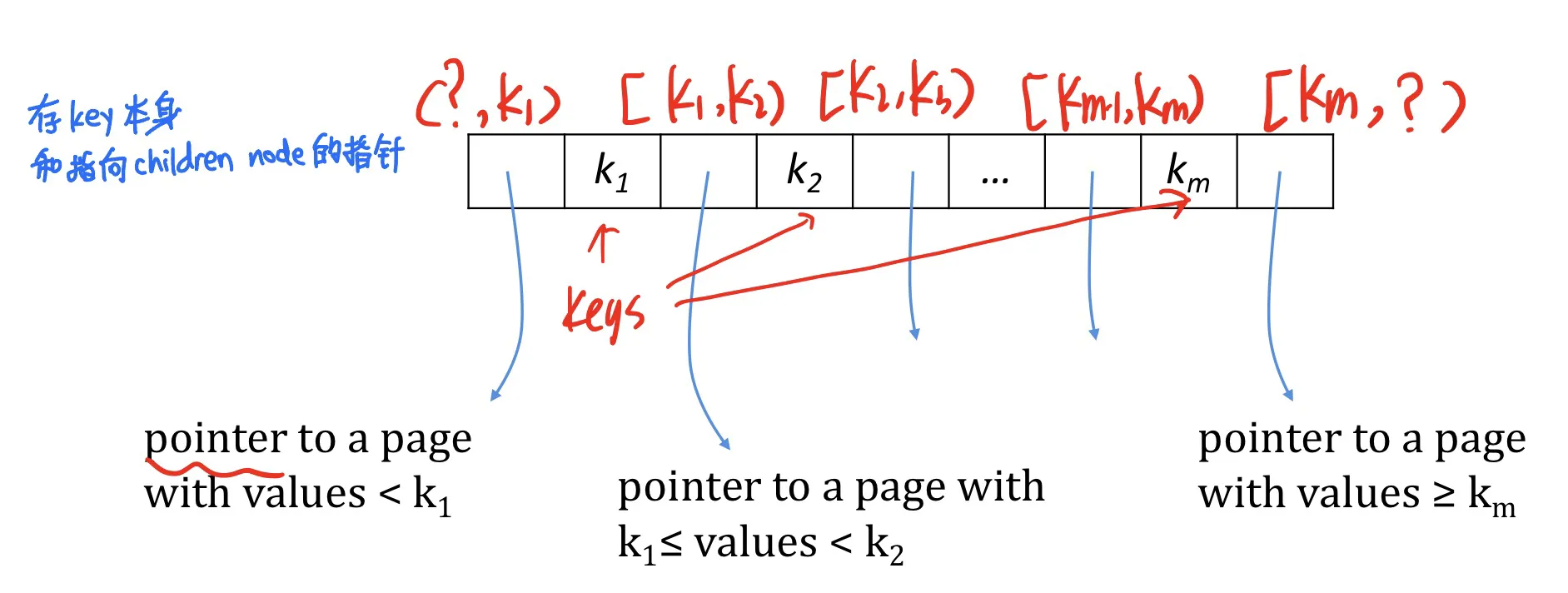
A leaf node with entries has pointers to records, and ptrs to next and prev leaves
B+ tree operations
Search
- Start from root node
- Examine index entries in non-leaf nodes to find correct child
- traverse down until a leaf node reached
- equality search: done
- range search: traverse leaves sequentially
Insertion
Search: find the leaf node where the entry belongs
Insert data entry in L
- If L has enough space, Done
- Otherwise, we must split (recursively)
TODO:
Deletion
- Find leaf node
- Remove the entry
- If is at least half-full, done
- If has only entries
- try to redistribute borrowing entries from a neighboring sibling
- if redistribution fails, merge and sibling (must delete an entry from the parent of )
Lec 24. B+ Tree & Bitmaps
Duplicate search keys in B+ Tree
Solution #1: use overflow pages
Solution #2: consider <key,rid> as the new unique key
Fan-out
Fan-out f: the number of pointers to child nodes coming out of a non-leaf node.
binary trees 的 fan-out 是 2; B+ tree 的 fan-out 是 ()
Fill-factor
Fill-factor F: the percent of available slots in the B+ tree that are filled ()
通常 <1 这样方便插入
Height
Height H: non-leaf nodes 的 level 数量
- 如果只有root node则height=0
- IO requirement for each search = h
Key compression
非叶子节点可以不存整个key, 只存key的前面一部分
Bitmap index
…
Bit-slice index
…
- Bitmap are better for low cardinality domains (e.g. 仅三种可能的值(true,false,null) 则bitmap更合适)
- Bit-slices are better for high cardinality domains
- Both are more space efficient than B+ tree.
- 缺点: 插入的时候要移动很多bit
Lec 25. Advanced indexes
Log-structured merge tree (LSM)
(对于log文件, 仅append到尾部, 复杂度O(1)并且是sequential IO)
LSM tree: optimizes for writes (by log structure) while maintaining good search performance.
Simple version: 2-level LSM Tree
分C0 tree和C1 tree
- Insert into C0 tree
- Lookup: seach in both C0 and C1
- Rolling merge: when C0 is full, merge a portion of it to C1 (merge 之后数据是 sorted 的)
C1 tree中的B+tree可以100% full.
…
Lec 27. Relational Operators I
Selection operator
Selectivity: 满足条件的 tuple 数量占比
File scan: 扫描全部 复杂度O(N)
Index scan
- Hash index: O(1) 但仅可用于 equality predicates
- B+ tree index: (height + X) I/Os
- clustered: X = #selected records / records per page
- unclustered: X = # selected tuples in the worst case
Conjunctive Normal Form (CNF)
(不要与 BCNF, 3NF 混淆!)
CNF的形式: (A\or B \or C) \and (D \or E)
Every selection condition can be expressed in CNF.
Index matching
Index matching: An index matches a selection condition if the index can be used to retrieve tuples that satisfy the condition.
Hash index match 的条件: equality predicate for each attribute in the search key
B+ tree index match: prefix of search key
(B+ tree index 不要求=, > < >= 等也可以; 不要求 each predicate, 是 prefix 即可)
Selection with disjunction
- If a subset of terms in a disjunction has matching indexes
- e.g. A=7 OR B=5, hash index on A 不行
- If every term in a disjunction has a matching index
- e.g A=7 OR B>5, hash index on A & B+ tree on B,
- take the union of rid
Projection
SELECT DISTINCT
Two approaches to eliminate duplicates
- sort based
- hash based
Lec 28. Relational Operators II
Join
Nested loop join
naive implementation
Tuple granularity
1
2
3for each tuple t_r in R
for each tuple t_s in S
join t_r with t_s if condition satisfiedIO cost =
= number of pages in R
= number of pages in S
= number of tuples in R
Page granularity
1
2
3for each page P_r in R
for each page P_s in S
join tuples in P_r with tuples in P_sIO cost =
requires more CPU computation for each loop iteration
Blocked nested loop join
B = number of pages in buffer pool
1 | |
(将B-2个page和另1个page作join, 而不是仅将2个page join)
IO cost =
if R fits in memory, IO cost =
Index nested loop join
1 | |
S has an index on the join attribute
好处: 不需要扫描整个S
IO cost =
( is the IO cost for searching an index)
Sort merge join
- Step 1: Sort R and S on the join attribute using external merge sort (R和S都要按照join key排序)
- Step 2: Read the sorted relations in the buffer and merge
- 用类似于 merge sort 中的 merge 方法
- 对于 duplicates, 需要 backup
- IO cost of read and merge =
- no backup:
- backup: (最坏情况是所有的key都相同, 两两join)
- 如果R和S已经按照join attribute排序则可以跳过第一步
Hash join
Lec 30. Query Optimization I
Convention: left child is the outer table
Materialize: create a temporary table to hold the intermediate results
Joins are commutative (交换律) and associative (结合律)
Many databases consider only left-deep plans
Lec 31. Query Optimization II
System catalog
Catalog tables: special tables that store the descriptive information of every table and index
Information in the catalog:
- for each table: table name, file name, attribute name & type, index name, …
- for each index: index name, structure, search key
- for each view: view name & definition
Cost estimation
Table cardinality: the number of tuples NTuples® (unique rows) for each table R
Table size: NPages®
Index cardinality: the number of distinct key values NKeys(I) for each index I
Index size: the number of pages INPages(I) for each index I (for B+ tree index, INPages = number of leaf pages)
Index height: the number of nonleaf levels IHeight(I) for each index I
Index range: the min present key value ILow(I) and max IHigh(I) for each index I
Computational cost estimation
reduction factor: ratio of the expected result size to the input size
estimated output size = max size * product of the reduction factors for the terms in the WHERE clause
IO cost estimation
Lec 32. Concurrency control
Transaction basics
Transaction: a sequence of many actions considered to be one atomic unit of work
1 transaction can contain multiple actions
ACID properties
Atomicity: 所有的action要么全部发生要么全不发生
Consistency: 经过 transaction 之后必须仍然consistent (合法, e.g 满足constraints)
Isolation: transaction的执行相互隔离
Strong isolation level
Serializability: Execution of transactions produces the same results as some serial execution
Durability: once a transaction commits, its effects must persist
Naive DB
satisfies: atomicity, serializable, isolation, durability
disadvantage: performance
Two-phase locking (2PL)
naive DB: DB-granularity exclusive locking
2PL: fine-grained locking
- A lock is in shared (for read) or exclusive (for write) mode
- growing phase: acquire but do not release locks
- shrinking phase: release but do not acquire locks
- 2PL is serializable
- Deadlock is a challenge
Deadlock
- deadlock detection: DBMS维护waits-for graph并周期性检查是否有cycles, 如果有则强制abort一条transaction来破坏cycle
- no-wait: 一条transaction碰到conflict的时候自己主动abort
- no wait, no deadline
- disadvantage: starvation: one transaction always aborts
- wait-die: 遇到conflict时, 如果自己优先级更高则wait, 优先级低则self-abort
- no deadlock, no starvation
- wound-wait: 遇到conflict时, 如果自己优先级更高则preemptively abort别人, 优先级低则自己等待
- no deadlock, no starvation
Lec 33. Optimistic concurrency control
pessimistic concurrency control
Strict 2PL
- acquire the right type of locks (write data - exclusive lock, read data - shared lock)
- release all locks together only after the transaction commits or aborts (必须在commit或abort之后才能release锁, 且必须一次release完所有的锁, 不能gradually)
Centralized OCC
key idea: ignore conflicts during transaction execution, resolve conflicts lazily only at a transaction’s completion time
Read phase
twrite: write to local write set (no modification to the database)
tread: read from either the local write set or the database
tdelete: mark delete in local delete set (no modification to the database)
Validation phase
transaction i 进入 validation phase 时会赋一个 transaction number
(transaction number 递增)
TODO
Write phase
把local buffer中的东西写入database
(all written values become global; all created nodes become accessible; all deleted nodes become inaccessible)